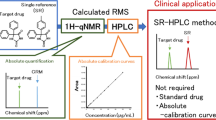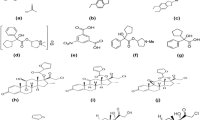Abstract
A chiral reversed-phase high-performance liquid chromatography (RP-HPLC) method was developed for the enantiomeric resolution of methoprene, isopropyl (2E,4E)-(R,S)-11-methoxy-3,7,11-trimethyl-2,4-dodecadienoate, and the determination of enantiomeric purity of the (S)-methoprene, isopropyl (2E,4E)-(S)-11-methoxy-3,7,11-trimethyl-2,4-dodecadienoate. Separation and identification of methoprene enantiomers were investigated using a chiral selector tris(4-methylbenzoate) on the polysaccharide backbone. Good baseline enantioseparation was achieved on ChiralCel OJ-3R column under RP-HPLC condition consisting of methanol and water in a ratio of 80 and 20 (% v/v) with adjusted to appropriate pH using 0.1% formic acid. The best resolutions were achieved using protic methanol than basic acetonitrile for neutral methoprene chiral analysis. The test concentration used in this study is 0.4 mg mL−1. Resolutions between (S)-methoprene and its enantiomer were above 2. The flow rate and column temperature were 1.0 mL min−1 and 40 °C, respectively. Detection was carried out at 260 nm using a diode-array detector (DAD). Developed method was validated in accordance with ICH guidelines for specificity, limit of detection and limit of quantification, linearity, accuracy, precision, ruggedness, and robustness. The method revealed an excellent linearity (R2 = 1) with a low limit of detection (0.0392–0.0456 μg mL−1) and a low limit of quantification (0.1189–0.1382 μg mL−1). Recoveries were within 98.9–99.5%. The proposed method was found to be suitable and accurate for the determination of enantiomeric purity of (S)-methoprene.








Similar content being viewed by others
Data availability
All required data are included in this manuscript.
Code availability
Not applicable.
References
Henrick CA (1995) Juvenoids. In: Godfrey CRA (ed) Agrochemicals from natural products. Marcel Dekker, Inc., New York, NY, USA, pp 147–213
Devillers J (ed) (2013) Juvenile hormones and juvenoids. CRC Press, Boca Raton, FL, USA
Henrick C, Ko J, Nguyen J, Burleson J, Lindahl G, Gundy DV, Edge J (2002) Investigation of the relationship between (S)-methoprene and deformities in anurans. J Am Mosq Control Assoc 18(2):214–221
Henrick C, Anderson R, Staal G, Ludvik G (1978) Insect juvenile hormone activity of optically active alkyl (2E,4E)-3,7,11-trimethyl-2,4-dodecadienoates and of arylterpenoid analogues. J Agric Food Chem 26(3):542–550
Wang I, Moorman R, Burleson J (2003) Isocratic reversed-phase liquid chromatographic method for the simultaneous determination of (S)-methoprene, MGK264, piperonyl butoxide, sumithrin and permethrin in pesticide formulation. J Chromatogra A 983:145–152
Zhang T, Nguyen D, Franco P (2010) Reversed-phase screening strategies for liquid chromatography on polysaccharide-derived chiral stationary phases. J Chromatogra A 1217:1058–1055
Chankvetadze B (2020) Recent trends in preparation, investigation and application of polysaccharide-based chiral stationary phases for separation of enantiomers in high-performance liquid chromatography. TrAC Trends Anal Chem 122:115709–115718
Tarafder A, Miller L (2021) Chiral chromatography method screening strategies: past, present, and future. J Chromatogra A 1638:461878–461905
Wang H, Shen J, Wu Y, Sun X, Ke Y (2021) Enantioseparation of cloprostenol on the polysaccharide chiral stationary phase: Influence of the mobile phase on enantioselective adsorption. J Chromatogra A 1653:462413–462420
Agathokleous EA, Stavrou IJ, Kapnissi-Christodoulou C (2022) Comparison of cyclofructan- cyclodextrin- and polysaccharide-based chiral stationary phases for the separation of pharmaceuticals. Anal Bioanal Chem 414:1323–1333
Liu W, Gan JJ (2004) Separation and analysis of diastereomers and enantiomers of cypermethrin and cyfluthrin by gas chromatography. J Agric Food Chem 52:755–761
Sekhon B (2009) Chiral pesticides. J Pestic Sci 34(1):1–12
Perez-Fernandez V, Garcia MA, Marina ML (2010) Characteristics and enantiomeric analysis of chiral pyrethroids. J Chromatogra A 1217:968–989
Merino MD, Lancioni C, Padro J, Castells C (2020) Chiral separation of several pesticides on an immobilized amylose tris(3-chloro-5-methylphenylcarbamate) column under polar-organic conditions. Influence of mobile phase and temperature on enantioselectivity. J Chromatogra A 1624:461240–461249
Liu W, Gan L, Lee S, Werner I (2005) Isomer selectivity in aquatic toxicity and biodegradation of bifenthrin and permethrin. Environ Toxicol Chem 24:1861–1866
Spoendlin C (1994) Determination of enantiomeric purity of (S)-methoprene technical. Sandoz Pharma AG, Basel
International Council for Harmonization (2005) ICH Q2 (R1), validation of analytical procedures: text and methodology. ICH Geneva, Switzerland
Acknowledgements
The authors would like to thank Jinren Ko, Lynn Pierce, and Jack Nguyen for their useful discussions and comments.
Funding
The authors have not disclosed any funding.
Author information
Authors and Affiliations
Contributions
The study concept and design, methodology, material preparation, data collection and analysis were performed by I-HW. Investigation, conceptualization, supervision, project administration, resources, and review and editing were performed by RM. Data curation, validation, formal analysis, and review and editing were performed by YL. The first draft of the manuscript was written by I-HW, and all authors commented on previous versions of the manuscript. All authors read and approved the final manuscript.
Corresponding author
Ethics declarations
Conflict of interest
The authors declare that they have no known competing financial interests or personal relationships that could have appeared to influence the work reported in this paper.
Research involving human participants and/or animals
This article does not involve any studies with human participants or animals performed by any of the authors.
Additional information
Publisher's Note
Springer Nature remains neutral with regard to jurisdictional claims in published maps and institutional affiliations.
Rights and permissions
Springer Nature or its licensor holds exclusive rights to this article under a publishing agreement with the author(s) or other rightsholder(s); author self-archiving of the accepted manuscript version of this article is solely governed by the terms of such publishing agreement and applicable law.
About this article
Cite this article
Wang, IH., Moorman, R. & Liu, Y. Development and Validation of Chiral Reversed-Phase HPLC Method for the Determination of Enantiomeric Purity of (S)-methoprene. Chromatographia 85, 959–968 (2022). https://doi.org/10.1007/s10337-022-04194-4
Received:
Revised:
Accepted:
Published:
Issue Date:
DOI: https://doi.org/10.1007/s10337-022-04194-4




